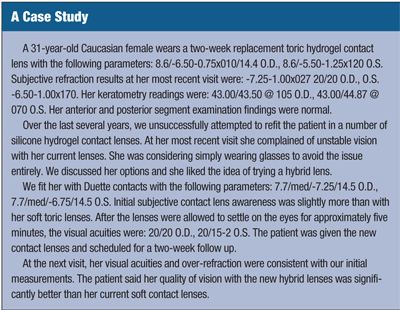 Astigmatic contact lens wearers are some of the most challenging—and most rewarding—patients to fit with contact lenses. There are a number of astigmatic contact lens designs that work remarkably well for most patients. These include the prism ballasted design of Air Optix for Astigmatism (Alcon), Biofinity Toric (CooperVision) and Purevision 2 for Astigmatism (Bausch + Lomb), all of which can correct up to 2.25D of astigmatism.1-4 The Acuvue Oasys for Astigmatism (Vistakon) has an accelerated stabilization design that also corrects for up to 2.25D of astigmatism. All of the lenses have large diagnostic fitting sets that allow for most prescriptions to be fit with lenses at the initial office visit.
Astigmatic contact lens wearers are some of the most challenging—and most rewarding—patients to fit with contact lenses. There are a number of astigmatic contact lens designs that work remarkably well for most patients. These include the prism ballasted design of Air Optix for Astigmatism (Alcon), Biofinity Toric (CooperVision) and Purevision 2 for Astigmatism (Bausch + Lomb), all of which can correct up to 2.25D of astigmatism.1-4 The Acuvue Oasys for Astigmatism (Vistakon) has an accelerated stabilization design that also corrects for up to 2.25D of astigmatism. All of the lenses have large diagnostic fitting sets that allow for most prescriptions to be fit with lenses at the initial office visit.
However, we do occasionally see patients whose astigmatism falls out of the range of parameters for these lenses, or who may benefit from other modalities of astigmatic lenses. This month we will review lens options for these patients who do not conform to traditional toric lens options.
The Daily Disposable Lens
Daily disposable lenses are a one-time only option available to patients requiring spherical lens powers for several years. They are now also available for astigmatics in a wide range of parameters. This lens is an excellent option for part-time wearers, those who suffer from ocular allergies, have sensitivities to lens care solutions or those who prefer the convenience of a new lens everyday.
Dailies Toric (Alcon) lenses are available in the following axes: 180, 020, 070, 090, 110 and 160. They come in both -0.75D and -1.50D of astigmatic power, with spherical power ranging from +4.00D to -8.00D. The lens has markings at both three o’clock and nine o’clock, and the dual thin lens is designed to optimize stability.5
Recently released 1-Day Acuvue Moist for Astigmatism (Vistakon) is available in the following axes: 180, 020, 070, 090, 110, 160 and 180, and includes the -0.75D, -1.25D and -1.75D astigmatic powers. For those patients needing 2.25D of astigmatic correction, it is available at the following axes: 180, 020, 090 and 160, and in sphere powers between +4.00 and -9.00D. This lens features an accelerated stabilization design and has lens markings at the six o’clock and 12 o’clock positions.4
 The Low Toric Option
The Low Toric Option
For patients who have astigmatism less than 0.75D but notice a blur to their vision when fit with single-vision contact lenses, a low toric contact lens option exists. Hydrogel Vision Corporation’s Extreme H2O 54% Toric LC features a prism ballasted lens design, made of hioxifilcon D material, that provides 0.65D of cylinder correction.6 It is available in 30º increments around the clock starting at 30º. These lenses work well for highly acute observers that have less than 0.75D of cylinder correction, and are unsatisfied with the visual acuity they obtain with a spherically equivalent lens.
Specialty Soft Toric Lenses
There are a number of laboratories that can produce custom lathed soft toric contact lens options. Many of the these laboratories specialize in difficult to fit patients and provide the ability to offer a wide array of astigmatic patients optimal correction of their astigmatism through novel hydrogel materials. New to the market within the last year, Definitive material (produced by Contamac) provides the only custom silicone hydrogel material. This material works well for high astigmatic patients wishing to wear soft lenses. This material is available from Art Optical, Metro Optics, Unilens and XCel.7-10 This breakthrough is an important advancement in custom soft contact lenses as these patients usually have the highest prescriptions, and thus require the benefits of higher oxygen permeability that silicone hydrogel material can offer.
Hybrid Lens Technology
The Duette lens (SynergEyes) is a hybrid produced of a high Dk rigid gas-permeable center surrounded by a silicone hydrogel skirt. It has a number of improvements over its predecessor, Synergeyes A. With the Duette lens, you can assess the fit with regular fluorescein without concerns of it absorbing into the soft skirt component of the lens. The modified design of the Duette lens resembles a more aligned fit with respect to the central RGP portion, compared to it’s predecessor, the A lens. The fit is manipulated by altering the base curve of the soft skirt portion as opposed to the base curve of the RGP portion.11
This lens works remarkably well for those astigmatic patients that prefer the quality of vision offered by an RGP with on-eye awareness more similar to that of a soft lens. This lens should be replaced every six months.
The Rigid Gas-Permeable Alternative
There is a place for RGP lenses in any practice that sees astigmatic patients. At times, you will find that your patients do remarkably well with a spherical back surface RGP; the tear lens in these instances will compensate for corneal astigmatism.
Unfortunately, as the amount of astigmatism increases, it becomes harder to correct corneal astigmatism with spherical RGP due to lens flexure. Lens flexure will cause the RGPs to contour to the cornea, decreasing the effective tear lens power created between the posterior surface of the lens and the cornea. In these instances, patients will need additional astigmatic correction because of under-correction secondary to the tear lens.
Either a back surface toric lens or a bitoric lens work remarkably well under these circumstances. In these instances, the posterior surface of the RGP contours more to the curvature of the cornea. This stabilizes the lens on the surface of the eye and also delivers much of the astigmatic power directly through the contact lens, which makes it less dependent on the tear lens. (Additional information and resources for fitting toric patients with RGP lenses can be found at
www.rgpli.org.)
Corneoscleral lenses are an alternative to traditional small-diameter RGPs. These lenses range from 13mm to 15mm in diameter and are designed to distribute their weight over the cornea and sclera. This weight distribution, plus the fact that these lenses move very little with the blink, helps significantly reduce lens awareness when properly fit. They provide the benefit of an RGP lens correction option for patients with high amounts of corneal cylinder. This is a remarkable option for those patients who benefit from RGP optics, but have a difficult time with adaptation to the lens.
Although we can fit most of our astigmatic patients with traditional soft toric lenses, we are lucky to have a number of viable options for those patients who need alternative options. Taking the time to familiarize yourself with the current market options will help you keep more of your astigmatic patients successfully wearing contact lenses, and reduce the rate of dropouts.
1. Air Optix. Available at:
www.airpoptix.com (accessed Feb 2012).
2. CooperVision. Available at:
www.coopervision.com (accessed Feb 2012).
3. Bausch + Lomb. Available at:
www.bausch.com (accessed February 2012).
4. Vistakon. Available at:
www.jnjvisioncare.com (accessed February 2012).
5. Ciba Vision. Available at:
www.dailies.com (accessed Feb 2012).
6. Hydrogel Vision Corporation. Available at:
www.hydrogelvision.com (accessed February 2012).
7. Art Optical. Available at:
www.artoptical.com (accessed Feb 2012).
8. Metro Optics. Available at:
www.metro-optics.com (accessed Feb 2012).
9. Walman Optical. Available at:
www.xcelcontacts.com (accessed Feb 2012).
10. Unilens. Available at:
www.unilens.com (accessed Feb 2012).
11. Duette. Available at:
www.synergeyes.com/duette (accessed Feb 2012).


